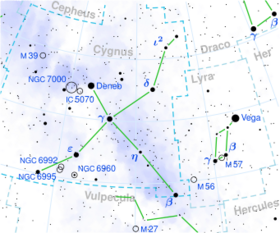Astronomy:Phi Cygni
Phi Cygni, Latinized from φ Cygni, is a binary star[11] system in the northern constellation of Cygnus. It is faintly visible to the naked eye with an apparent visual magnitude of 4.70.[2] The annual parallax shift is 12.25 mas[1] as measured from Earth, which yields a distance estimate of around 266 light years. It is moving further from the Sun with a radial velocity of +4.5 km/s.[4]
φ Cygni is a double-lined spectroscopic binary system, which means that the absorption lines of both components are visible in the spectrum. The two sets of spectral lines are almost identical and both stars are assigned a spectral type of K0III, meaning they have evolved into giants. They are considered to be red clump giants, stars that have begun core helium fusion and lie on the horizontal branch but because of their metallicity and the size of their hydrogen envelope they are found very close to the red giant branch.[8][12] The two stars are assumed to have the same age, which would be around 650 million years.[9][6] The pair have an orbital period of 434.208 days, or 1.2 Earth years, a semimajor axis of 26.9 mas, and a high eccentricity of 0.56.[7]
References
- ↑ 1.0 1.1 1.2 1.3 1.4 1.5 van Leeuwen, F. (2007). "Validation of the new Hipparcos reduction". Astronomy and Astrophysics 474 (2): 653–664. doi:10.1051/0004-6361:20078357. Bibcode: 2007A&A...474..653V. http://www.aanda.org/articles/aa/full/2007/41/aa8357-07/aa8357-07.html. Vizier catalog entry
- ↑ 2.0 2.1 2.2 2.3 Fernie, J. D. (June 1969), "UBV observations of miscellaneous stars", Journal of the Royal Astronomical Society of Canada 63: 133–135, Bibcode: 1969JRASC..63..133F.
- ↑ 3.0 3.1 3.2 3.3 3.4 Pourbaix, D (2000). "Resolved double-lined spectroscopic binaries: A neglected source of hypothesis-free parallaxes and stellar masses". Astronomy and Astrophysics Supplement 145 (2): 215–222. doi:10.1051/aas:2000237. Bibcode: 2000A&AS..145..215P.
- ↑ 4.0 4.1 Pourbaix, D. et al. (2004), "SB9: The Ninth Catalogue of Spectroscopic Binary Orbits", Astronomy & Astrophysics 424 (2): 727–732, doi:10.1051/0004-6361:20041213, Bibcode: 2004A&A...424..727P.
- ↑ Anderson, E.; Francis, Ch. (2012), "XHIP: An extended hipparcos compilation", Astronomy Letters 38 (5): 331, doi:10.1134/S1063773712050015, Bibcode: 2012AstL...38..331A.
- ↑ 6.0 6.1 Armstrong, J. T; Hummel, C. A; Quirrenbach, A; Buscher, D. F; Mozurkewich, D; Vivekanand, M; Simon, R. S; Denison, C. S et al. (1992). "The orbit of Phi Cygni measured with long-baseline optical interferometry - Component masses and absolute magnitudes". Astronomical Journal 104: 2217. doi:10.1086/116396. Bibcode: 1992AJ....104.2217A.
- ↑ 7.00 7.01 7.02 7.03 7.04 7.05 7.06 7.07 7.08 7.09 7.10 7.11 7.12 7.13 7.14 7.15 Massarotti, Alessandro; Latham, David W; Stefanik, Robert P; Fogel, Jeffrey (2008). "Rotational and Radial Velocities for a Sample of 761 HIPPARCOS Giants and the Role of Binarity". The Astronomical Journal 135 (1): 209–231. doi:10.1088/0004-6256/135/1/209. Bibcode: 2008AJ....135..209M.
- ↑ 8.0 8.1 8.2 Fekel, F. C (2004). "The Spectroscopic Orbit of φ Cygni, a System with Two Late-Type Giants". The Environment and Evolution of Double and Multiple Stars 21: 63. Bibcode: 2004RMxAC..21...63F.
- ↑ 9.0 9.1 Soubiran, C; Bienaymé, O; Mishenina, T. V; Kovtyukh, V. V (2008). "Vertical distribution of Galactic disk stars. IV. AMR and AVR from clump giants". Astronomy and Astrophysics 480 (1): 91–101. doi:10.1051/0004-6361:20078788. Bibcode: 2008A&A...480...91S.
- ↑ "* phi Cyg". SIMBAD. Centre de données astronomiques de Strasbourg. http://simbad.u-strasbg.fr/simbad/sim-basic?Ident=%2A+phi+Cyg.
- ↑ Eggleton, P. P.; Tokovinin, A. A. (September 2008), "A catalogue of multiplicity among bright stellar systems", Monthly Notices of the Royal Astronomical Society 389 (2): 869–879, doi:10.1111/j.1365-2966.2008.13596.x, Bibcode: 2008MNRAS.389..869E Vizier catalog entry
- ↑ Armstrong, J. T; Hummel, C. A; Quirrenbach, A; Buscher, D. F; Mozurkewich, D; Vivekanand, M; Simon, R. S; Denison, C. S et al. (1992). "The orbit of Phi Cygni measured with long-baseline optical interferometry - Component masses and absolute magnitudes". Astronomical Journal 104: 2217. doi:10.1086/116396. Bibcode: 1992AJ....104.2217A.
 |


